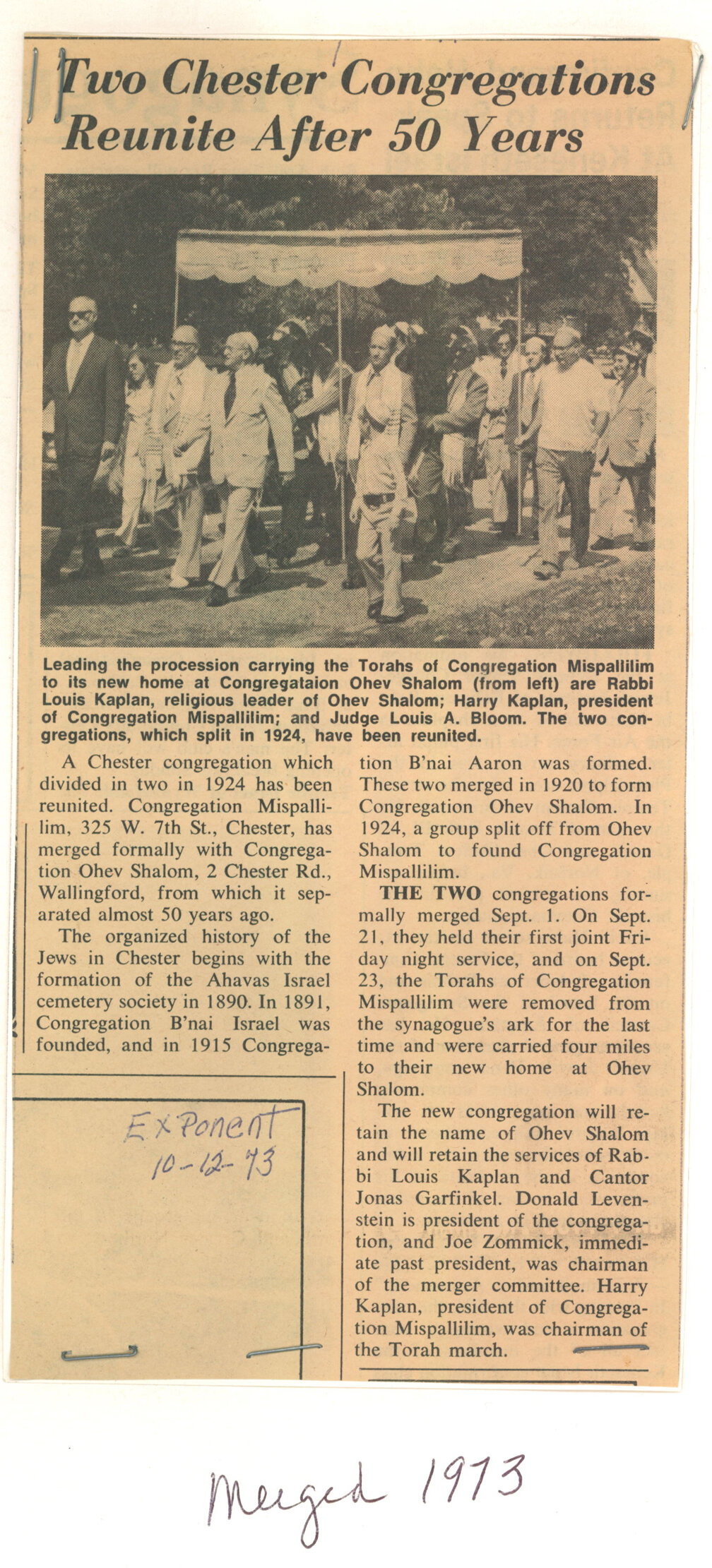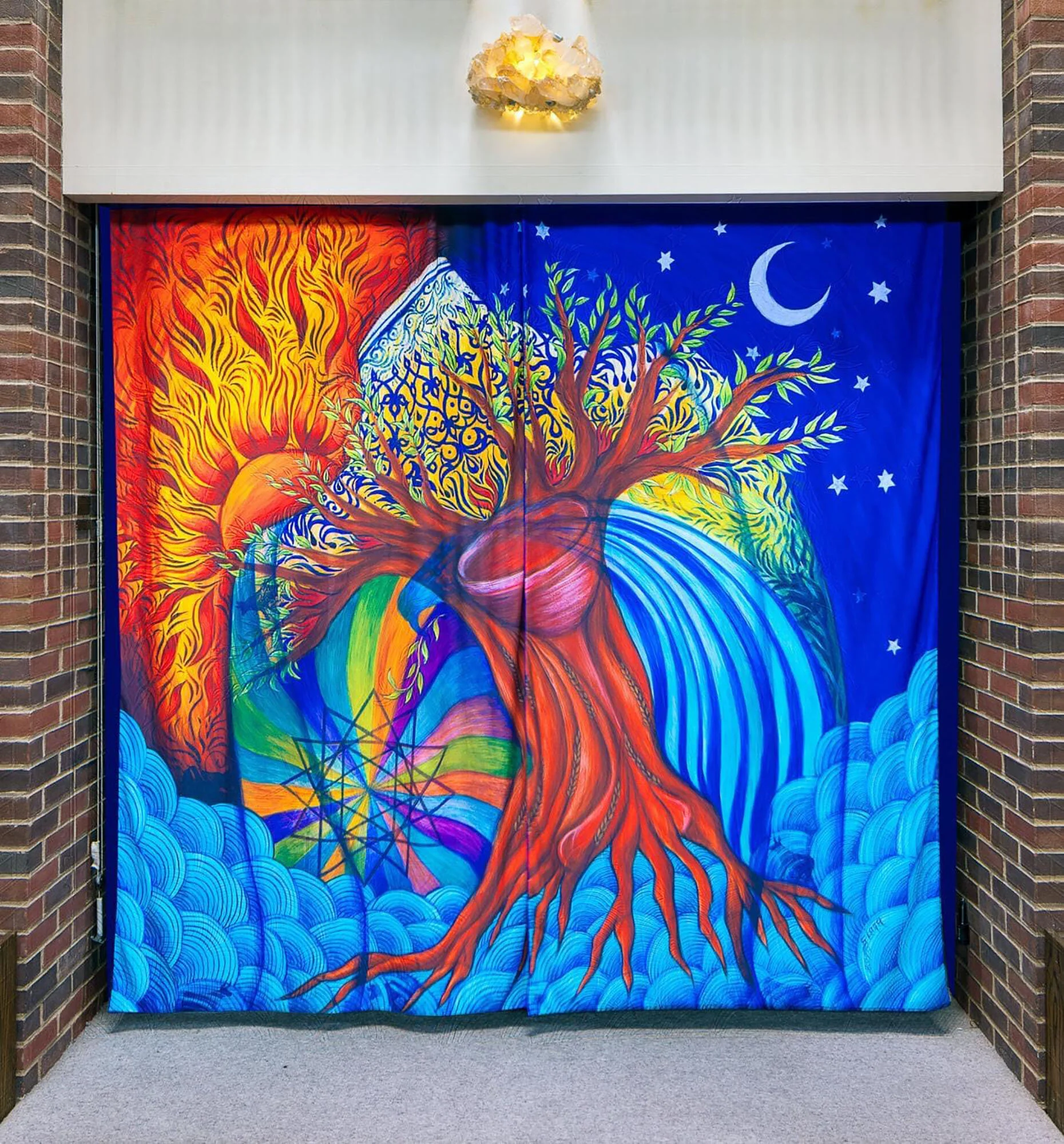Ohev Shalom Raises the Curtain on a Second Century
The congregation of Ohev Shalom moved from Chester to Wallingford in 1965. On January 28, they carried their Torah scrolls to the new building by hand in a procession. Courtesy of Ohev Shalom
When he was a boy, Bruce Godick used to attend services at Congregation Ohev Shalom in Chester. He remembers riding the Red Arrow bus from Wallingford Elementary School to the synagogue three afternoons a week for Hebrew School, stopping at Woolworth’s to pick up popcorn or candy on the way.
The grand old building on Eighth Street had a swimming pool and a basketball court. It functioned not only as a house of worship but also as a community center, Godick recalls. He was 10 years old when the congregation built its current, modern synagogue on Chester Road in Wallingford.
Godick has belonged to Ohev Shalom his whole life. He served as co-chair of the synagogue’s centennial celebration planned for June 2020, which had to be postponed because of the COVID-19 pandemic. The disappointment hit him hard. “It tore my heart out to see it fall apart the way it did,” he recalls.
There would be no tents full of dressed up congregants or celebratory toasts. But one part of the commemoration would still go ahead. The synagogue’s new ark curtain, commissioned for the anniversary, was finished and installed on schedule.
The Curtain
Siona Benjamin’s ark curtain was installed in time for Rosh Hashanah services this year. Photo: Jack Zigon
An ark curtain covers a synagogue’s ark, the sacred container holding Torah scrolls on which the first five books of the Hebrew Bible are inscribed. Such curtains are seldom designed to be eye-catching, though many congregations reserve a special white one for the High Holiday services of Rosh Hashanah and Yom Kippur.
Ohev Shalom’s new curtain is anything but plain. A vibrant red tree spreads its branches across a background of rich blues. An orange and yellow sun blazes in one corner, a silvery moon and stars in another. “You see different colors swirling,” says Jeremy Gerber, the congregation’s rabbi. He points out a coat “right by where the sun is. You can see the collar, the shoulder.”
Swirling colors and a coat on a synagogue curtain? The narrative implied by the layered design may not be instantly clear, Gerber notes, but many viewers will soon pick out pieces of the story of the biblical prophet Joseph. Seven small, shadowy cows and seven ears of grain illustrate one of the dreams Joseph famously interpreted for Pharaoh. The rays of the sun form the shape of the Hebrew letter shin, a symbol of God’s presence. A dove perches on the central tree with a twig in its beak, a symbol of peace — and of this synagogue: in Hebrew, “Ohev Shalom” means “lover of peace.”
Former Ohev Shalom president Bonnie Breit likens the curtain to the illustration-rich “Where’s Waldo” children’s books: the more you look, the more you find. She says the curtain offers congregants “the opportunity to focus on something, then go to the story and see where that might resonate.”
The curtain was designed by Siona Benjamin, an Indian-American-Jewish artist who first visited Ohev Shalom in 2019 for a weekend workshop. “In the Jewish community, there’s not always a great awareness of Jews of color, and people who are growing up in other parts of the world with Judaism,” Gerber says. Born in Bombay as a Bene Israel Jew — a community of Jews that has lived in India for centuries — Benjamin has what Gerber describes as “a story of being different (the Other) in India, and then moving to the States and being different (the Other) here.”
The history of Jews in Delaware County stretches back to the 1800s, Gerber says. He’s cognizant that antisemitism persisted here well into the twentieth century. Members of his congregation remember Jews not being able to buy houses in certain neighborhoods. Local clubs like the Springton Country Club and the Swarthmore Swim Club barred them from membership. Because of restrictions in Swarthmore and Wallingford, “Brookhaven Swim Club was primarily where the Jews went,” Gerber reports.
This local history and the artist’s personal story converge, for Gerber, with the drama of Joseph, an outsider figuring out how to thrive in Egypt. The prophet’s story of oppression and empowerment, he says, “feels like the story of Judaism in America. Or of Judaism everywhere.”
Repairing the World
Oppression and empowerment are important themes at Ohev Shalom. They run through the story of the curtain, the congregation’s contemplation of its history and aspirations on the occasion of its centennial, and also its involvement in the broader community. Seven years ago, Gerber founded FUSE, the Fellowship of Urban Suburban Engagement, to bring people of different religions, races, and classes together.
In the past, Gerber says, different religious organizations “might do a clean up together, or we might do a food drive.” These are valuable activities, he notes, but what was missing was “a sense of togetherness, and caring about one another’s communities.”
“Ohev has this incredible history in Chester,” Gerber points out. One of his predecessors, Rabbi Ira Sud, taught at Crozer Theological Seminary, where one of his students was a young Martin Luther King Jr. But when Gerber first arrived at Ohev in 2009, congregants tended to talk about any connection to Chester using the past tense. “Like you’re talking about Atlantis,” he recalls. “And I would say, ‘Isn’t it just down the road?’”
Breit says Gerber urged the congregation to become “not only a spiritual home, but a community home for people.” She says that repairing the world — “tikkun olam” in Hebrew — has become a guiding principle for the congregation.
Much of Ohev’s social outreach work is supported by a fund established in 2010 by an anonymous donor. Under the fund’s terms, any money withdrawn is split equally between the needs of the congregation and the outside world. “We can’t take anything for ourselves unless we match it in the community,” Breit explains.
When launching FUSE, Ohev Shalom invited a wide range of religious and community organizations to participate. The steering committee now includes members from the Wallingford Presbyterian Church, Congregation Beth Israel in Media, Chester’s Making a Change Group, and elsewhere. The organization’s central tenet is that coming together to share meals and engage in difficult conversations can help forge lasting personal connections.
Breit, a former hospital administrator who describes herself as an “old white lady with gray hair,” was invited to lunch after one of the group’s events by a Black rap artist and filmmaker in his twenties. “We started meeting together,” she recalls. “He came to my house. I’ve met his family.” She says she helped him with his resume, and he introduced her to new music and movies.
Ohev congregant Stephen Lehmann met Cory Long of the Chester nonprofit Making a Change Group through FUSE. Before long, Lehmann joined the nonprofit’s development committee.
Gerber says that such connections were exactly what he hoped for. FUSE “has become a positive force in the community,” he says.
Meanwhile, he continues to lead his congregation, mostly via Zoom. He calls the video interface infuriating as a form of communication, but says it’s also an equalizer. “There isn’t a bad seat in the house,” he jokes. At High Holiday services, when the pews are crowded, this is especially welcome.
It was hard, this year, to celebrate the holidays virtually, and to have no congregation on hand when the curtain was unveiled. Ohev Shalom sent holiday cards with the curtain’s image to all its members. That way everyone could hold the story of Joseph — the outsider who overcame oppression — in their hands.






















